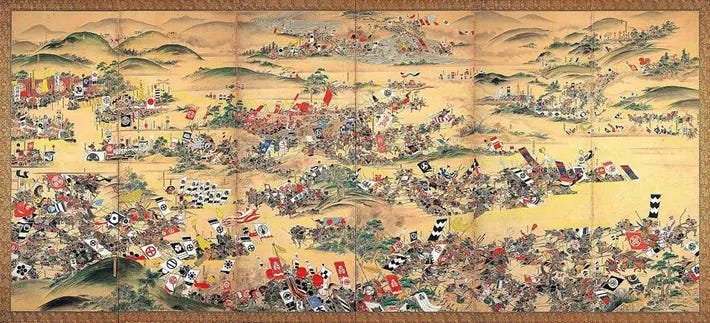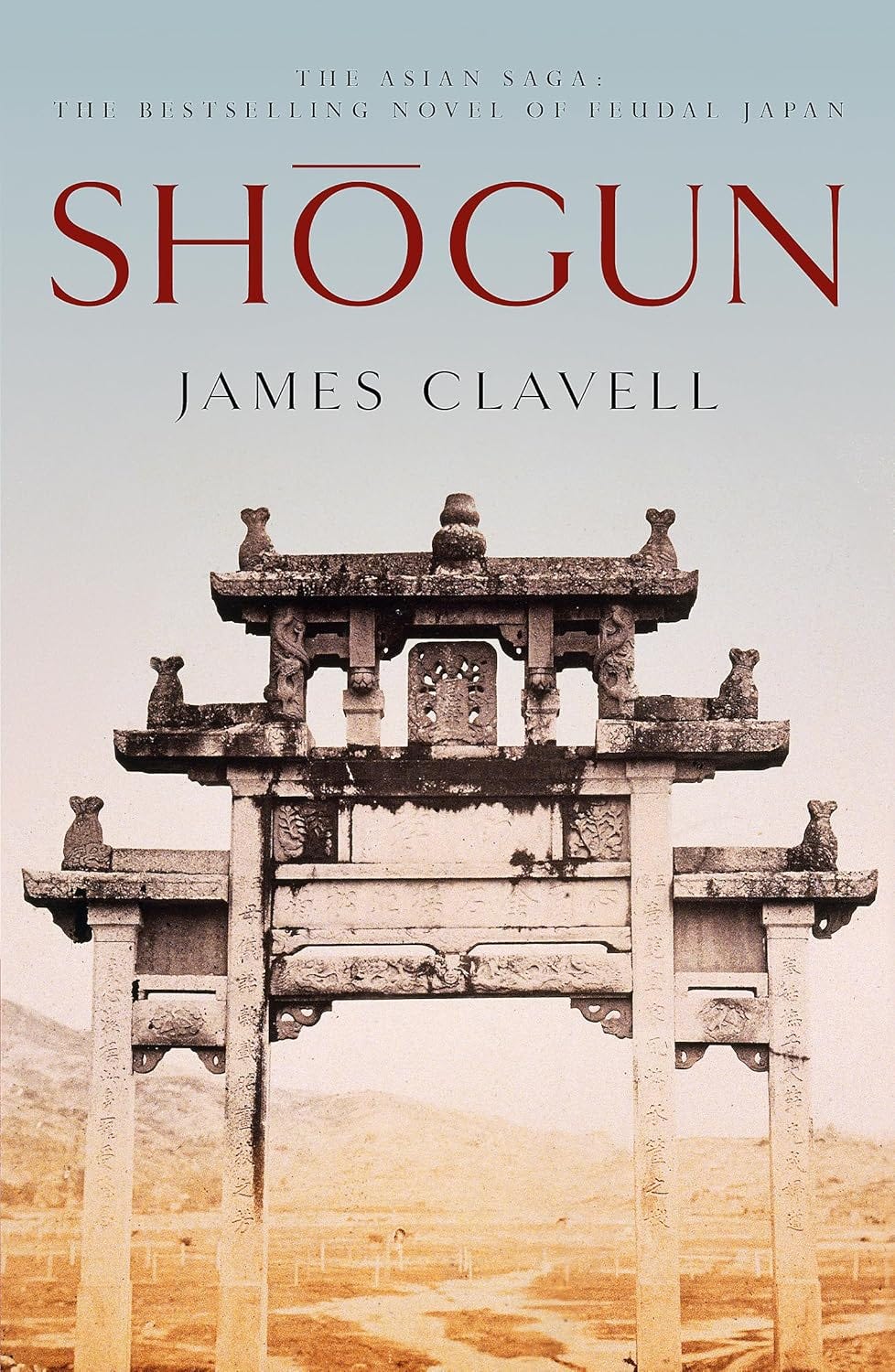Shōgun: From Page to Screen
A detailed comparison of James Clavell’s novel to the FX Masterpiece
What makes Shōgun such a timeless epic? Is it the sweeping historical detail, the gripping political intrigue, or the intense cultural clashes that make James Clavell’s novel so compelling? How does the story of John Blackthorne—a stranded English sailor navigating the complex world of 17th-century Japan—continue to captivate audiences decades after its publication? And does the 2024 FX adaptation on Hulu live up to the legacy of both Clavell’s novel and the beloved 1980 miniseries?
Much like the book, FX’s Shōgun follows John Blackthorne (Cosmo Jarvis), the English pilot of the Erasmus, who, along with his surviving crew, is taken prisoner in the fictional Japanese village of Anjiro. Under the watchful eye of samurai Kasigi Omi (Hiroto Kanai), Blackthorne awaits judgment from Omi’s uncle, Kashigi Yabushige (Tadanobu Asano), a powerful daimyo who controls his fate. Renamed “Anjin” (meaning “pilot” in Japanese), he soon finds himself entangled in the perilous political machinations of Lord Yoshi Toranaga (Hiroyuki Sanada), a master strategist fighting to secure his survival against the other four members of the Council of Regents. Navigating this treacherous landscape, Blackthorne is guided by Lady Toda Mariko (Anna Sawai), a noblewoman and Christian convert burdened by the weight of her disgraced family’s legacy, who serves as both his interpreter and a bridge between their two worlds.
Both the novel and its screen adaptations capture this historical drama, yet they diverge in focus, character development, and representation. The FX-Hulu series, in particular, shifts away from the predominantly Western lens of John Blackthorne to a more authentic Japanese viewpoint. This adaptation enhances historical authenticity through meticulous set design, period-accurate costuming, and dialogue primarily in Japanese.
While remaining faithful to Clavell’s vision, the series grants greater narrative agency to characters like Lord Toranaga and Lady Mariko, enriching their arcs with depth and complexity. It also explores cultural nuances largely absent from the novel, expanding the story beyond the Western perspective of Blackthorne. Though Clavell’s Blackthorne initially serves as the audience’s entry point into Japan, by the end, he is no longer the dominant perspective.
In the series, one of the most loved character Kashigi Yabushige, played by Tadanobu Asano, is a more fleshed-out version of the character Yabu from James Clavell's novel, with the show's creators weaving in their own writings to create a more complex and relatable character. While the character is known as Yabu in the book, the series uses the name Yabushige, which is considered a more authentic name for a Japanese lord in the 1600s.
Mariko’s character receives even greater depth in the show, particularly through her Akechi heritage. While she is well-developed in the book, she remains somewhat passive. The adaptation enriches her story with flashbacks of her childhood, her Catholic faith, and her internal conflicts. The show also highlights her pride in her Akechi lineage, an aspect downplayed in the book.
Blackthorne and Mariko’s romance is another significant difference. In the novel, their affair develops during their travels in a small group, allowing them more privacy. Mariko even begins to comprehend European notions of love. The show, however, opts for a slower emotional buildup, delaying their physical relationship until the night of Mariko’s death. This restraint heightens the tragedy of their bond, making their final moments together all the more poignant. Blackthorne’s grief is particularly profound in the adaptation, as he never explicitly tells Mariko he loves her. He mourns not just her loss but the time they never had together. Another scene in which he shows his willingness to act as her second during her seppuku demonstrates the depth of his love, as he honours her beliefs even when they conflict with his own.
One of the most dramatic departures from the novel is the portrayal of the Battle of Sekigahara and Toranaga’s victory. The book remains historically accurate, depicting a bloody battle with thousands of casualties. Toranaga ultimately buries Ishido alive, leaving him to suffer for days. The series, however, opts for a bloodless victory, with Toranaga outmanoeuvring Ishido politically rather than militarily. This reinforces his image as a master strategist who avoids unnecessary bloodshed. Yet, the show does not shy away from sacrifice—key figures like Lady Mariko, Nagakado (Toranaga’s brash son played Yuki Kura), and Hiromatsu (Toranaga’s hardened general portrayed by Tokuma Nishioka ) meet brutal ends (while their counterparts survive in the book), underscoring the heavy price of Toranaga’s triumph.
Another major shift in the adaptation is the expanded perspectives on other characters, particularly Ishido Kazunari (Takehiro Hira) and Lady Ochiba (Fumi Nikaido). The book, primarily told through Blackthorne’s point of view, presents other characters through his observations or dialogue. The show, however, fleshes out Ishido and Lady Ochiba with dedicated scenes and flashbacks, making them multidimensional figures rather than mere obstacles to Toranaga’s rise.
The show also establishes a childhood friendship between Lady Ochiba and Lady Mariko, a relationship that does not exist in the book. Shōgun entwines Ochiba and Mariko's pasts, which will affect their respective allegiances. As a result of their childhood friendship, Lady Ochiba withdraws her support for Ishido after Lady Mariko's death. Lady Ochiba is frustrated with Ishido after Mariko dies in the book, but only because Ishido acts foolishly. Mariko and Ochiba's bond led Toranaga to victory and added depth to their characters.
Another standout character Usami Fuji (Moeka Hoshi) in the series is portrayed as a more layered and tragic character compared to James Clavell’s novel, with the show expanding her role and deepening her interactions with John Blackthorne. While the book presents Fuji with a more limited character arc, the series gives her a compelling backstory, beginning with the seppuku of her husband and infant child in the first episode—a defining moment that shapes her resilience. Unlike the novel, where Fuji’s presence is overshadowed by Blackthorne’s relationship with Mariko, the adaptation strengthens their bond, culminating in a poignant finale where they find solace in each other’s grief. This final scene, absent from the book, takes place on a boat, symbolising both closure and a shared sense of loss.
A notable difference between the novel and the series is the pacing. Clavell’s novel is 1100 pages dense, filled with meticulous detail about Japanese customs, politics, and warfare, which can be overwhelming for some readers. The series, by contrast, streamlines certain aspects, making it more accessible to a modern audience. Some subplots may be condensed or restructured for the sake of pacing, but the essence of the story remains intact.
The novel also deeply explores cultural contrasts between Japan and Europe, examining differences in love, food, hygiene, and clothing. Clavell uses Blackthorne’s transformation to critique Western superiority while highlighting Japan’s uniqueness. The series, however, shifts focus away from this theme, emphasising Japan’s internal conflicts over its cultural distinctions from Europe.
In the end, Shōgun endures because it transcends the historical epic genre, offering a masterful exploration of power, identity, and survival in a world of shifting allegiances. Whether through Clavell’s richly detailed novel or Hulu’s visually stunning adaptation, the story continues to captivate, evolve, and find new meaning with each retelling. The novel immerses readers in feudal Japan’s complexities through meticulous world-building, while the series breathes fresh life into its characters, giving them greater agency and emotional depth. Both versions stand as compelling works in their own right, proving that Shōgun is not just a story about the past—it is a timeless epic that continues to resonate today.
And for fans of the show, there is more Shōgun to look forward to. FX, Hulu, and the estate of James Clavell are developing two additional seasons, expanding on the critically acclaimed drama. The saga of Shōgun is far from over, promising even greater depth and intrigue in the years to come.
(Written by Lora Nay, a poet, freelance writer, and biotechnologist with a passion for literature, nature, and storytelling. Nay’s poetry, book and movie reviews, along with reflections on pop culture, can be read on her blog and Instagram)









